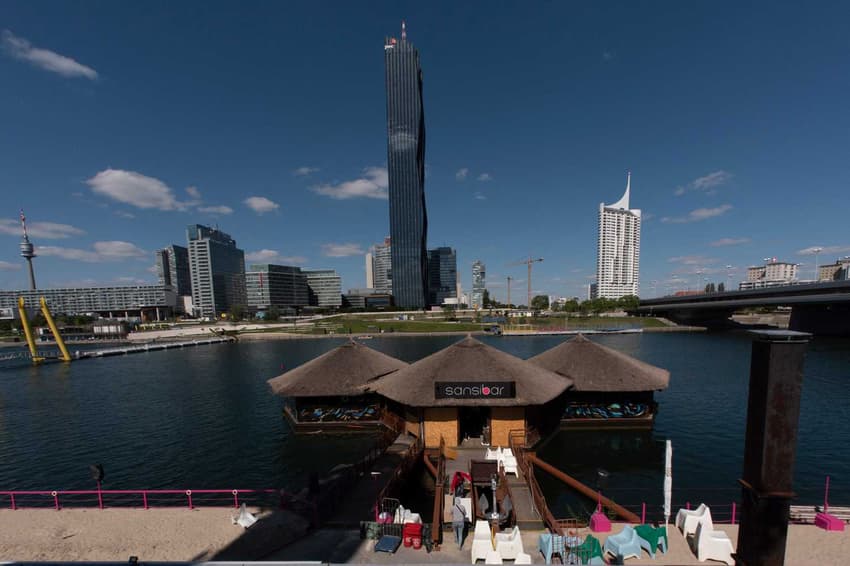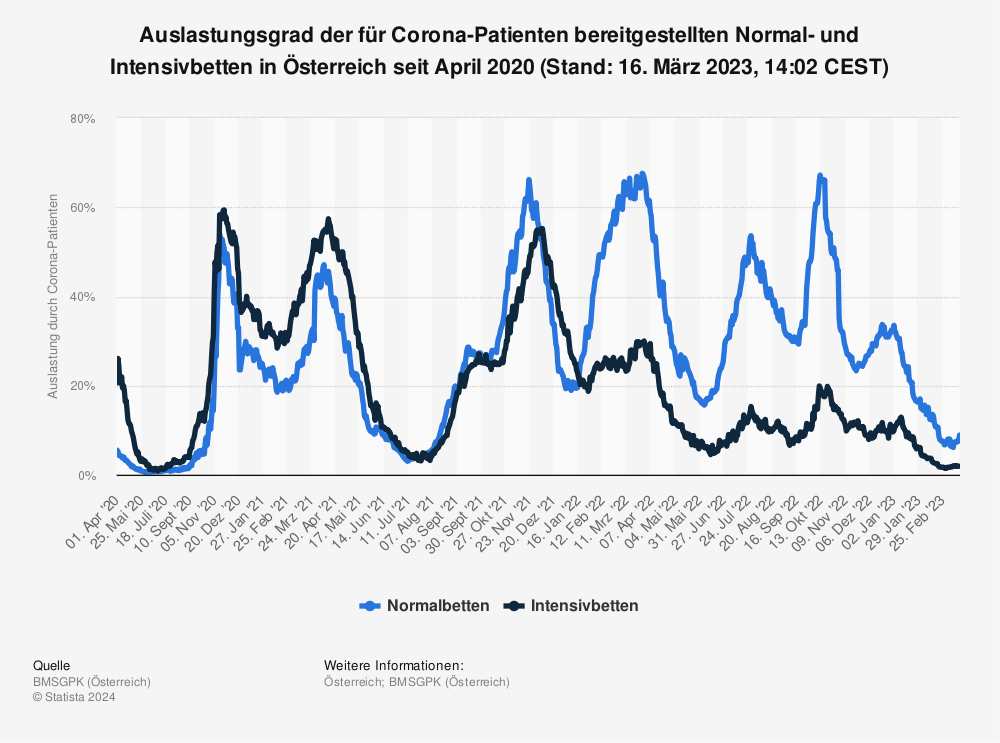Lockdown extension or regional openings: What will Austria decide?

Austria will this week decide whether or not lockdown will be extended. Here’s what you need to know.
Earlier in the month, Austrian authorities said the next steps in reopening - including allowing restaurants to open outdoor areas and removing some restrictions on sport - would take place from March 27th if infection rates remained low.
Amid a rise in new case numbers and a sharp decline in available hospital beds however, such relaxations seem unlikely.
The Local reported last week that coronavirus infections had hit a three-month high, putting a planned easing of lockdown restrictions on 27th March throughout the Alpine state in jeopardy.
Here’s what you need to know.
What is the current infection situation in Austria?
Put simply, it’s not good.
The number of infections has been steadily climbing in Austria since lockdown measures were relaxed on February 8th.
The number of new coronavirus infections crossed the 3,000 mark on Friday, the first time since mid-December.
During last week 18,498 people were infected with coronavirus, an average of 2,643 every day. The seven-day incidence, or number of coronavirus infections per 100,000 population has risen from 176 to 208 within one week.
What about intensive care beds?
While infection rates have been rising since the start of February, it’s the spike in intensive care unit (ICU) admissions which is now the major cause for concern.
The situation is particularly severe in Vienna and Upper Austria, where 60 percent of the 373 occupied beds for coronavirus sufferers can be found.
"It looks like the number of occupied intensive care beds will be greater than in previous waves," said Nina Brenner-Küng, spokesperson for the Vienna Health Association.
Non-ICU beds also filling up
Non-ICU beds are also filling up - with 1,395 occupied as at Monday, an increase of 94 on the previous day’s figures.
Operations in Vienna are likely to be postponed soon in order to expand ICU capacities. Public hospitals have already started to cooperate with private and religious hospitals in order to get operations done.
The following graphic shows the situation in terms of hospital beds and in ICUs in Austria.

Mehr Statistiken finden Sie bei Statista
Why are intensive care and general hospital beds filling up?
Although it is impossible to know exactly why hospital beds are filling up, the simple reason is that infection rates are rising again.
There are two primary reasons for this: the relaxation of the strict lockdown rules on February 8th and the British variant.
Hospitalisations of all kinds have been accelerated by the spread of the British coronavirus mutation throughout Austria.
A recent study from Denmark said that not only is the British variant more contagious, but it gets people sicker than known variants.
According to the study, cases of the British variant lead to a 64 percent higher risk of hospital stays than known variants.
Tyra Grove Krause, the technical director of the Danish Health Service Center, said "our numbers point in the same direction as several other studies from the UK showing that B.1.1.7 may cause more serious disease."
Another study from the journal Nature Medicine found that the variant had a 64 percent higher risk of death than other known variants.
Community testing tends to pick up more low risk cases, but the researchers said that if the findings were able to be generalised to other populations, the variant has the "potential to cause substantial additional mortality compared with previously circulating variants".
Simon Clarke, Associate Professor in Cellular Microbiology at the University of Reading, said the increased lethality added to its faster spread meant that "this version of the virus presents a substantial challenge to healthcare systems and policy makers. "It also makes it even more important people get vaccinated when called," he added.
Austria’s Der Standard newspaper reports that the hospitalisation rates are highest in the states where the British mutation has been present for the longest period of time.
What does it mean for the planned opening?
While it is impossible to know what will be decided before the Austrian government makes a final decision, Austrian media reports that a nationwide relaxation appears unlikely on March 27th.
The government takes into account a wide range of factors in making lockdown decisions, from infection rates to hospitalisations.
Kronen Zeitung reports that this is unlikely before mid-April, while Der Standard reports that regional rather than nation-wide relaxations are the probable course of action.
This has already taken place in Vorarlberg, where restaurants have been allowed to serve guests indoor and outdoor since March 15th.
According to the APA news agency, the government wants to "find tailor-made solutions for the affected regions".
While details are at this stage relatively scarce, this could include allowing states to open up again as has happened in Vorarlberg, or particular regions or municipalities.
Comments
See Also
Earlier in the month, Austrian authorities said the next steps in reopening - including allowing restaurants to open outdoor areas and removing some restrictions on sport - would take place from March 27th if infection rates remained low.
Amid a rise in new case numbers and a sharp decline in available hospital beds however, such relaxations seem unlikely.
The Local reported last week that coronavirus infections had hit a three-month high, putting a planned easing of lockdown restrictions on 27th March throughout the Alpine state in jeopardy.
Here’s what you need to know.
What is the current infection situation in Austria?
Put simply, it’s not good.
The number of infections has been steadily climbing in Austria since lockdown measures were relaxed on February 8th.
The number of new coronavirus infections crossed the 3,000 mark on Friday, the first time since mid-December.
During last week 18,498 people were infected with coronavirus, an average of 2,643 every day. The seven-day incidence, or number of coronavirus infections per 100,000 population has risen from 176 to 208 within one week.
What about intensive care beds?
While infection rates have been rising since the start of February, it’s the spike in intensive care unit (ICU) admissions which is now the major cause for concern.
The situation is particularly severe in Vienna and Upper Austria, where 60 percent of the 373 occupied beds for coronavirus sufferers can be found.
"It looks like the number of occupied intensive care beds will be greater than in previous waves," said Nina Brenner-Küng, spokesperson for the Vienna Health Association.
Non-ICU beds also filling up
Non-ICU beds are also filling up - with 1,395 occupied as at Monday, an increase of 94 on the previous day’s figures.
Operations in Vienna are likely to be postponed soon in order to expand ICU capacities. Public hospitals have already started to cooperate with private and religious hospitals in order to get operations done.
The following graphic shows the situation in terms of hospital beds and in ICUs in Austria.

Mehr Statistiken finden Sie bei Statista
Why are intensive care and general hospital beds filling up?
Although it is impossible to know exactly why hospital beds are filling up, the simple reason is that infection rates are rising again.
There are two primary reasons for this: the relaxation of the strict lockdown rules on February 8th and the British variant.
Hospitalisations of all kinds have been accelerated by the spread of the British coronavirus mutation throughout Austria.
A recent study from Denmark said that not only is the British variant more contagious, but it gets people sicker than known variants.
According to the study, cases of the British variant lead to a 64 percent higher risk of hospital stays than known variants.
Tyra Grove Krause, the technical director of the Danish Health Service Center, said "our numbers point in the same direction as several other studies from the UK showing that B.1.1.7 may cause more serious disease."
Another study from the journal Nature Medicine found that the variant had a 64 percent higher risk of death than other known variants.
Community testing tends to pick up more low risk cases, but the researchers said that if the findings were able to be generalised to other populations, the variant has the "potential to cause substantial additional mortality compared with previously circulating variants".
Simon Clarke, Associate Professor in Cellular Microbiology at the University of Reading, said the increased lethality added to its faster spread meant that "this version of the virus presents a substantial challenge to healthcare systems and policy makers. "It also makes it even more important people get vaccinated when called," he added.
Austria’s Der Standard newspaper reports that the hospitalisation rates are highest in the states where the British mutation has been present for the longest period of time.
What does it mean for the planned opening?
While it is impossible to know what will be decided before the Austrian government makes a final decision, Austrian media reports that a nationwide relaxation appears unlikely on March 27th.
The government takes into account a wide range of factors in making lockdown decisions, from infection rates to hospitalisations.
Kronen Zeitung reports that this is unlikely before mid-April, while Der Standard reports that regional rather than nation-wide relaxations are the probable course of action.
This has already taken place in Vorarlberg, where restaurants have been allowed to serve guests indoor and outdoor since March 15th.
According to the APA news agency, the government wants to "find tailor-made solutions for the affected regions".
While details are at this stage relatively scarce, this could include allowing states to open up again as has happened in Vorarlberg, or particular regions or municipalities.
Join the conversation in our comments section below. Share your own views and experience and if you have a question or suggestion for our journalists then email us at [email protected].
Please keep comments civil, constructive and on topic – and make sure to read our terms of use before getting involved.
Please log in here to leave a comment.